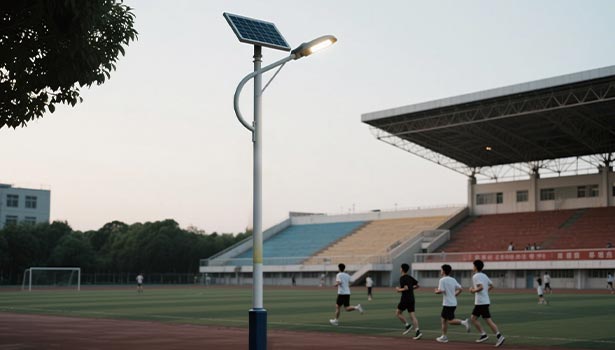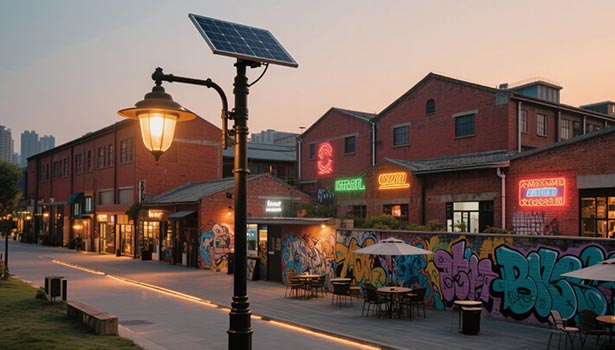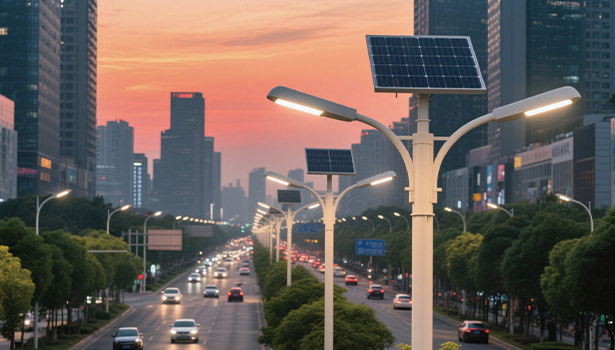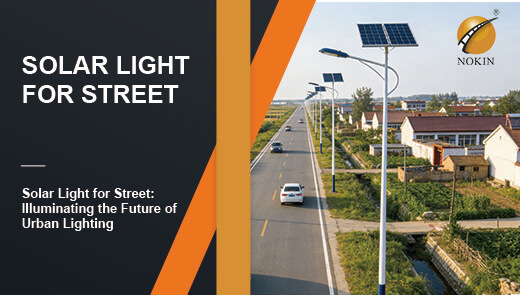What Are the Factors that Influence the Pricing of Solar Street Lights?
Against the backdrop of global renewable energy promotion and accelerated urbanization, solar street lights have become the mainstream lighting choice for municipal roads, parks, and rural development due to their advantages of “zero electricity costs, low maintenance, and environmental friendliness.”Whether procurement personnel for municipal projects or infrastructure managers for scenic areas and enterprises, all face the challenge of “significant price variations” when selecting solar street lights. This article systematically breaks down the four core factors influencing solar street light pricing and provides a practical guide to “avoiding low-price traps and selecting high-value products.” It helps readers understand the “logic behind pricing” to make more informed procurement decisions.

The Impact of Materials on the Price of Solar Street Lights
Solar Panels
Solar panels serve as the core component for absorbing solar energy, with their type and power directly impacting the street light's endurance. Currently, mainstream solar panels on the market fall into two categories: monocrystalline silicon and polycrystalline silicon. Monocrystalline silicon panels boast high conversion efficiency, reaching 18%-24%, along with a long service life and strong weather resistance. They can withstand harsh conditions like high temperatures and hail, making them more suitable for areas with insufficient sunlight or municipal roads requiring high lighting standards. However, their cost is relatively higher.
Polycrystalline silicon panels have slightly lower conversion efficiency (15%-18%) and a shorter lifespan (20-25 years), but they also demonstrate strong weather resistance. They are better suited for well-lit rural roads, parks, and similar settings, and their cost is lower than monocrystalline panels. Additionally, higher-power solar panels require more raw materials, leading to increased costs.
LED Light Source
The LED light source serves as the “illuminating core” of solar street lights. Variations in its quality directly impact brightness, lifespan, and energy consumption, which in turn affect overall cost. Standard LEDs offer luminous efficacy of 80-100 lumens per watt, a lifespan of approximately 20,000-30,000 hours, and a color rendering index (CRI) of 70-80. They exhibit noticeable light decay (over 30% brightness reduction) after 1-2 years of use but are relatively low-cost.
High-end LEDs offer higher luminous efficacy (120-150 lumens per watt), extended lifespans of 50,000-80,000 hours, a CRI of 80-90, and slower light decay. Though initially more expensive, their lower replacement frequency reduces long-term maintenance costs, creating a “cost-performance advantage.”
Batteries
Batteries store electricity converted by solar panels, serving as the key to “nighttime endurance.” Their type and capacity directly impact cost. Lead-acid batteries have short cycle life, low energy density, poor low-temperature performance, require regular maintenance, and are the lowest cost option.
Lithium-ion batteries offer longer cycle life, higher energy density, better low-temperature performance, and maintenance-free operation, though at a higher cost than lead-acid batteries. LiFePO4 batteries deliver the best overall performance, with a cycle life of 2000-3000 cycles, strong low-temperature capability (-30°C operation), high safety, and maintenance-free operation, but also the highest cost. Simultaneously, larger battery capacity increases energy storage requirements and proportionally raises costs.
Light Poles and Enclosures
The materials used for light poles and enclosures also impact pricing. Mainstream materials for poles are Q235 steel and aluminum alloy: Steel poles' cost is influenced by thickness and manufacturing processes, making them suitable for cost-sensitive applications; aluminum alloy poles are lightweight with excellent corrosion resistance, reducing long-term maintenance needs, but their raw material and processing costs are higher. The price difference between the two primarily stems from material density and anti-corrosion treatment processes.

For housings, premium solar street lights utilize IP65/IP67-rated waterproof materials (e.g., ABS engineering plastic, aluminum alloy) to effectively resist rain and dust ingress, ensuring stable operation at a higher cost. Lower-end products often employ standard plastics with poor waterproofing and dust resistance, prone to water ingress and short circuits during rainy seasons. While initial costs are lower, maintenance expenses significantly increase over time.
The Impact of Technology on Solar Street Light Pricing
Controller
Solar street light controllers primarily fall into two categories: PWM and MPPT. PWM controllers feature a simple structure and low cost, but their energy conversion efficiency ranges only between 70%-80%. This can lead to insufficient runtime during cloudy or rainy days, affecting lighting performance. They are suitable for scenarios with low endurance requirements.
MPPT controllers feature more advanced technology and higher costs, yet achieve conversion efficiencies of 90%-95%. They track the maximum power point of solar panels in real time, boosting endurance by over 30% during cloudy or rainy days to ensure stable lighting under complex weather conditions. Integrating IoT capabilities—such as remote meter reading and fault alerts—adds costs but reduces manual inspection workloads, yielding long-term savings in operational expenses and superior cost-effectiveness.
Smart Features
High-end solar street lights equipped with adaptive lighting and automatic dust removal increase upfront costs but enable “on-demand lighting,” reducing long-term energy consumption and maintenance expenses. Adaptive lighting adjusts brightness via human presence sensors and traffic flow detectors (automatically dimming when no pedestrians/vehicles are detected), cutting energy use by 30%-50%, extending battery life, and indirectly lowering replacement costs.
Automatic dust removal systems (e.g., brushes or high-pressure air jets), designed for high-dust environments, periodically clean solar panel surfaces. This prevents efficiency degradation (dust accumulation reduces efficiency by 10%-20%), ensures stable power generation, and reduces maintenance frequency due to insufficient runtime. The long-term value significantly outweighs the initial investment.
The Impact of Market Demand on Solar Street Light Pricing
In recent years, accelerated global urbanization and the advancement of national “dual carbon” goals have jointly driven rapid growth in solar street light demand. In the short term, this surge in demand may strain the supply of raw materials for solar panels and lithium batteries, driving up material costs and consequently increasing the retail price of solar street lights. However, long-term demand growth will prompt manufacturers to expand production capacity. By bulk-purchasing raw materials to reduce costs and optimizing automated production processes to enhance efficiency, economies of scale will gradually offset cost pressures. This may even lead to more reasonable pricing for street lights.
The Impact of Policy Support on the Price of Solar Street Lights
Subsidies and Tax Incentives
Multiple countries and regions worldwide have implemented policies to lower procurement barriers for solar street lights. Certain Chinese provinces offer subsidies for municipal solar lighting projects, covering a portion of procurement costs. Germany provides purchase subsidies for products meeting the “EU Ecodesign Directive” standards and exempts them from value-added tax, with these combined incentives significantly reducing buyer burdens.
Regulatory Requirements
Some regions enforce stricter product standards through regulations, indirectly driving demand for mid-to-high-end products and influencing pricing structures. For instance, since 2021, the EU mandates municipal street lights meet “Energy Efficiency Class A+” standards, phasing out inefficient incandescent bulbs and standard LED lights. This forces manufacturers to upgrade products, increasing the market share of mid-to-high-end street lights from 30% to 60%. While the average price has risen, long-term energy consumption costs have decreased by 40%, resulting in higher overall cost-effectiveness.

How to Choose a Cost-Effective Solar Street Light
Road Requirements
Different road widths, traffic volumes, and lighting conditions require distinct street light configurations. Blindly pursuing high-end options wastes costs. For rural paths, a 4-5 meter pole with a 15-20W light source, 50-80W solar panel, 60Ah/12V battery + PWM controller suffices. Forcing 8-meter poles and 60W light sources will incur unnecessary expenses.
Urban side streets require 6-7 meter poles, 30-40W light sources, 100-120W solar panels, 100Ah/12V batteries + MPPT controllers; Main thoroughfares require 8-10m poles, 50-60W light sources, 150-200W solar panels, 150Ah/12V batteries + MPPT+IoT controllers; For highway service areas/scenic zones (8-10 meters wide, high foot traffic fluctuations): Select 7-8 meter poles, 40-50W light sources, 120-150W solar panels, 120Ah/12V batteries + MPPT + sensor controllers to achieve energy-efficient lighting.
Detailed Configuration
Some low-end manufacturers may inflate specifications to attract customers—for example, labeling a 100W solar panel as 120W or a 100Ah battery as 120Ah. This often leads to insufficient runtime or brightness during actual use. Therefore, always request a “third-party testing report” from the manufacturer during procurement. If feasible, conduct on-site testing: Under sunny conditions, a 100W solar panel typically generates 0.4-0.5kWh daily. If actual output falls below 80% of the theoretical value—for example, a 100W panel producing less than 0.32kWh daily—it may indicate falsified specifications. Exercise extreme caution when selecting such products.
Warranty Period
Warranty duration serves as a “barometer” for product quality. High-quality solar street lights typically carry a 3-5 year warranty explicitly covering core components (solar panels, batteries, controllers). Be wary of products offering “1-year comprehensive warranty”—these may extend extended coverage only to non-core parts (e.g., casing), while core components (solar panels, batteries) receive just 6 months of protection. Subsequent failures would incur high replacement costs, making them uneconomical.
Prioritize brands offering “component-specific warranties,” such as those promising “5-year warranty for solar panels, 5-year warranty for batteries, and 3-year warranty for controllers.” While the initial cost may be higher than low-warranty products, the long-term warranty on core components mitigates future maintenance risks, offering better value over the entire lifecycle.
Brand
Low-cost “unbranded products” offer minimal upfront savings but boast failure rates exceeding 30% and lack after-sales support. Subsequent repair and replacement costs far outweigh initial savings. Evaluate brands through three key aspects: First, verify certifications like CE to ensure compliance with standards. Second, examine project portfolios—prefer brands with municipal engineering or large-scale park collaborations, as extensive case studies indicate greater reliability. Third, evaluate after-sales service: Verify local service centers and confirm fault response within 24 hours to prevent prolonged outages affecting usage.
Solar street light pricing is influenced by materials, technology, market dynamics, and policy factors. Avoid blindly chasing high prices or low-cost options. Instead, select configurations tailored to road requirements, verify test reports, and prioritize core component warranties and brand strength. This approach helps avoid low-price traps, enabling you to choose truly cost-effective products aligned with total life cycle costs. Every investment will then translate into stable, long-lasting lighting value.




